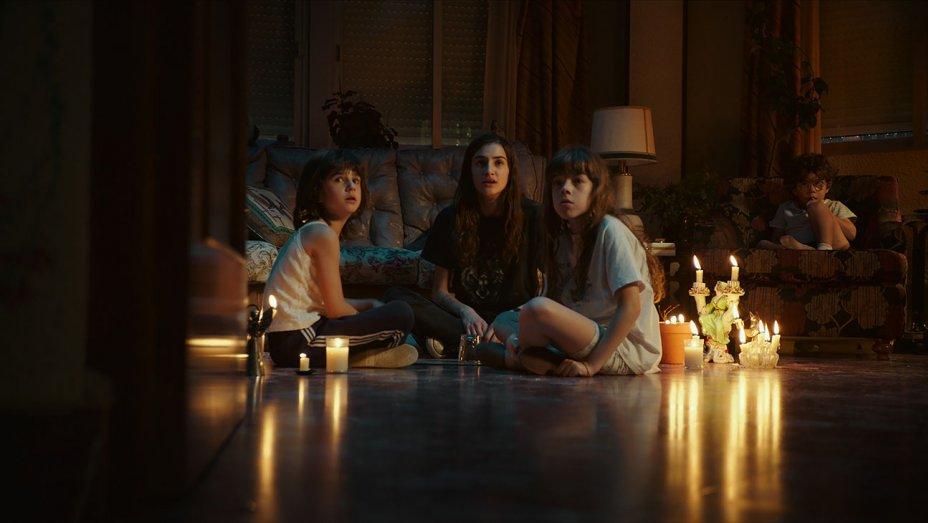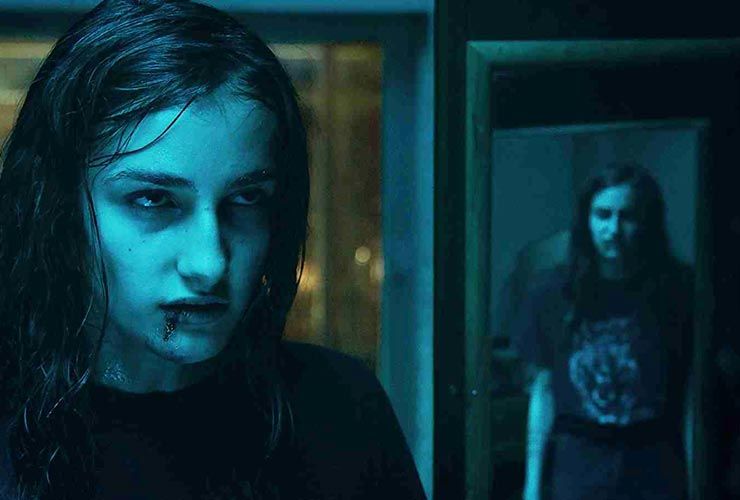VERONICA (8 out of 10) Directed by Paco Plaza;Written by Fernando Navarro and Paco Plaza; Starring Sandra Escacena, Bruna González, Claudia Placer, Iván Chavero, Ana Torrent, Consuelo Trujillo, Ángela Fabián, Carla Campra, and Chema Adeva; Not rated; Running time 105 minutes; On Netflix March 1, 2018.
This review will contain spoilers.
Set in Madrid in 1991, Veronica is Netflix’s new Spanish horror film that tells the story of a fifteen-year-old girl, Veronica (Escacena), experiencing some rather horrific events after a fateful encounter with Ouija board. And if the title sounds a bit familiar, it’s probably because this film has recently been grabbing headlines left and right, with various articles reporting that a large portion of viewers are unable to make it all the way through the film due to how scary it is. The cult-ish buzz around the film has taken on a life of its own, so let’s take a look at the film itself and see how it compares to the urban legends.
From the get-go, Veronica herself is one of the strongest parts of the film. Escacena is a young new actress who commands the screen from the moment she first appears. She is relatable and a joy to watch in the early scenes, as we see her being a mother figure to her three younger siblings. Inevitably, bad things happen when she attempts to reach out to her deceased father using the Ouija board. From there, Veronica starts to experience some truly awful visions and dreams and Escacena completely sells it. Even in Veronica’s most dire moments, Escacena never feels out her depth, with a performance that roots the film in a sincere and heartfelt emotionality. Having a character who is so likable and relatable at the core of the story makes the rest of the film that much more horrifying.

And she’s not alone. All of the child actors deliver incredibly convincing performances in a film that is populated by interesting characters. Even the role of the nun, who would generally be played as a straightforward archetype, becomes something much more. Sister Death (Trujillo) is a nun who smokes and talks openly with Veronica about her own sins and failures. It is a thrilling subversion of the status quo that makes the world of this film feel more relevant and alive, rather than just a warehouse of tired and trite horror clichés.
Writer/director Paco Plaza is certainly not new to the genre, having directed all of the REC films, and his expertise shows. The direction is assured and confident, with Plaza expertly crafting sequences that act as crescendos of suspense and terror. He also has a gift for making even the mundane seem startlingly frightening, with a couple of children’s toys being put to especially discomforting effect. The cinematography of the film is strikingly beautiful, with lots of unique lighting and color choices. Plaza and his crew stay away from the stark, realist lighting of most modern horror and instead strike a balance that is somewhere between Argento and Carpenter, a phantasmal mix of the surreal and reality.
Once Plaza really gets going, the film takes on a life of its own, but the first third or so features very little in the way of originality for its scares. It is standard supernatural-horror fare; lights flicker, crosses fall, doors open and close on their own. It is the kind of stuff that audiences have seen so much, especially in the last decade or so, that we are now completely desensitized to it. Therefore, some of the earliest horror beats don’t have quite the impact that the film is hoping for.
As the film goes on, it gets stranger and the scares and story move further away from the traditional wheelhouse and into things that are far more interesting. When Veronica and her siblings conduct a second séance to try and force the demon to leave them alone, Plaza puts the camera dead in the middle of all of the children and simply pans around the room slowly. It is the simplest of plays, yet so effective. Having such a limited and passing view of the children and their surroundings builds suspense and allows what we cannot see to be all the more horrifying, thanks to some stellar sound design and a great musical score.

The finale is surely what the film will come to be known for, as Plaza engineers the showdown to appear as though it is done in one long shot. As Veronica and her siblings desperately try to escape the demon, we do not get a succession of quick cuts or jump scares. We are simply forced to live in the moment and bask in the terror with them, a choice that makes these final moments strikingly invasive.
Even the final third-act reveal, as bonkers as it is, works incredibly well, thanks to the sufficient thematic groundwork that Plaza has been laying the entire film. Like the greatest of magicians, Plaza distracts viewers by calling attention to one aspect of possible thematic resonance with motifs like the painting of the deer being chased by the wolves or the repeating shots of the solar eclipse, only to later reveal what they were really being placed there for and twist the entire meaning of the film on its head. By the time Veronica is being carted out of the apartment on a stretcher and the camera pans down to focus on the wolf on her shirt, Plaza has pulled off an incredibly affecting ending that resonates far deeper than any standard horror ending could.
Veronica takes a stock horror premise and infuses it with great performances, compelling and likable characters, and assured and technically-inspired direction. The initial string of horror beats may be a bit underwhelming but the final third of the film more than makes up for any shortcomings it may have had early on. The urban legends seem to suggest the film is nigh unwatchable but I found just the opposite to be true for its final stretch: I couldn’t take my eyes off of it.
8 out of 10